Learn how to make fresh homemade ravioli (from scratch!) with easy step-by-step recipe instructions & video, plus a creamy, 5-ingredient cheese filling with fresh basil. No ravioli makers or molds required!
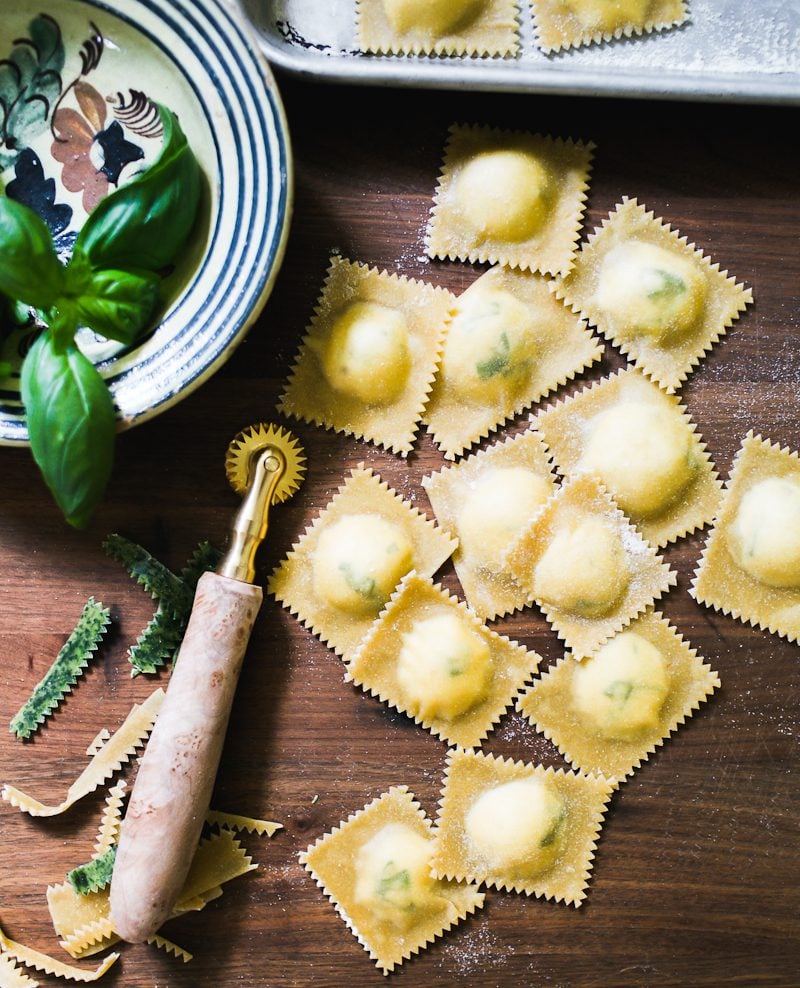
Once you’ve mastered fresh homemade pasta and homemade lasagna noodles, take what you know and make filled pasta, like homemade ravioli to level up your skill. They’re pillowy soft, super tender and can be stuffed with a variety of fillings! Use any of the following doughs to get started: my master pasta dough, sourdough pasta, or this fresh spinach pasta dough. All three options pair beautifully with my homemade pasta sauces.
But before you dive in, know this: homemade ravioli is a project. A pasta project. Do not attempt on a Tuesday night after work or soccer practice (or both). It takes time. Repetition. A glass of wine perhaps? Once you find a groove, the process will become surprisingly therapeutic and the results: absolutely spectacular.
How To Make Ravioli: What To Expect
My recipe and method is broken down into 4 main steps: making pasta dough, preparing the filling, rolling pasta dough into sheets and finally, assembling ravioli. You’ll end up with enough ravioli to feed up to 4 people with make-ahead storage options to streamline the process (yes! you can freeze them!).
I’ve also included a creamy, 5-ingredient cheese filling with ricotta, mascarpone and fresh basil that’s so light and delicate, full permission is granted to lick the spoon. So, say goodbye to doughy, overstuffed store-bought ravioli and HELLO to homemade fresh! It’s 100% worth it.
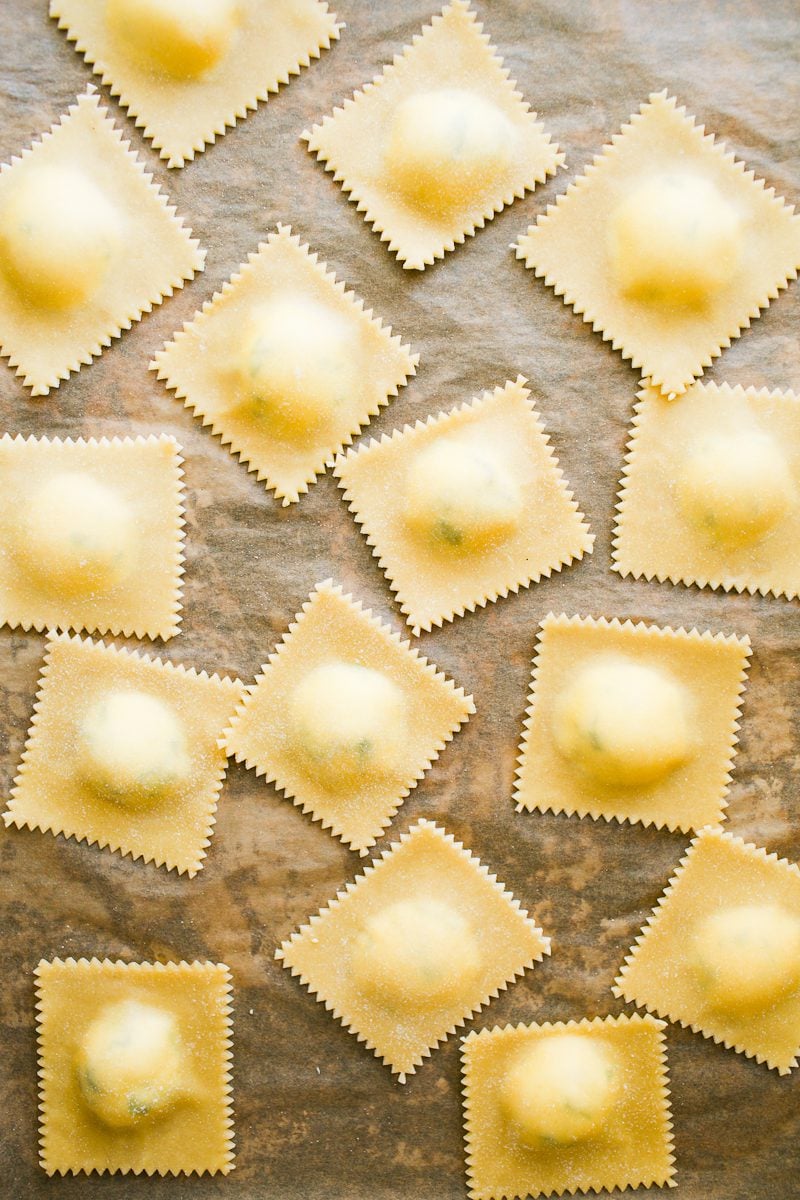
Homemade Ravioli Ingredients & Tools (You Will Need):
For the Pasta Dough:
- Tipo 00 Flour
- Eggs + Egg yolk
- Olive oil
For the Ravioli Cheese Filling:
- Whole Milk Ricotta (fresh homemade ricotta or store-bought)
- Mascarpone cheese
- Fresh Basil
- Parmesan Cheese
- Egg
Equipment: Kitchen Aid stand mixer (w/ roller attachment) OR hand-crank pasta machine and a fluted ravioli cutter.
Homemade Ravioli Tips
- Think ahead. Before you begin, remember two things: store-bought ricotta must be drained overnight (no exceptions!) AND you’ll need sauce to serve, like a simple pomodoro sauce. I tackle both 1-2 days in advance. See my sample cooking timeline.
- Drain store-bought ricotta. Skip this step, and you’ll be sorry. The cheese filling will be watery, grainy and seep out all over the place. I measured a whopping 80 g (3 oz) of residual liquid from a 454 g (1 lb) container of drained ricotta! Use any leftover ricotta to make my one-bowl Italian ricotta cake. Note: if using my fresh homemade ricotta recipe, you won’t need to drain it. The texture should be thick enough, however always use your judgement.
- Make space. You’ll need a large, clutter-free work surface to roll out the pasta dough (the kitchen table is ideal). Don’t overlook this tip. Rolled out pasta sheets can measure up to 3ft. long.
- Skip the fancy tools: You do not need ravioli molds or ravioli makers to get started. A simple ravioli cutter (aka: fluted pastry wheel) is sufficient for pretty decorative edges resemblant of baby shark teeth. Or, use a large knife and upgrade later.
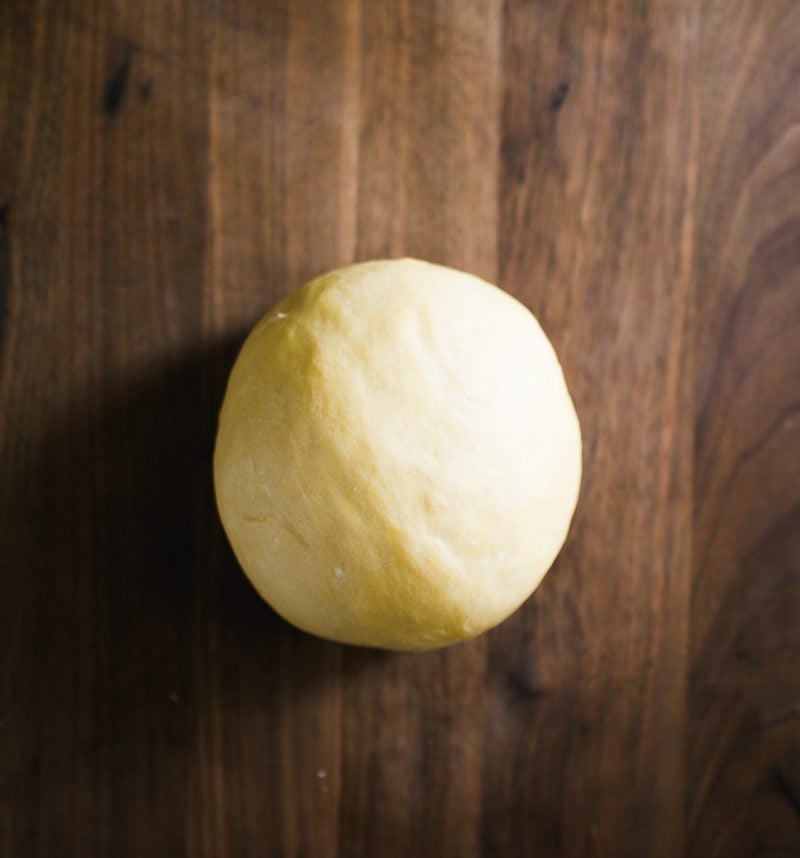
Step #1: Make Pasta Dough
- There are several ways to make fresh pasta dough. The food processor method is the fastest. To do so: add the flour, eggs and olive oil to a food processor fitted with the metal blade. Process to form dough, about 15-20 seconds. Remove to your work surface and cover with an upturned bowl for 5 minutes- it will be much easier to knead in the next step.
- Knead dough for 1-2 minutes to form a ball (don’t worry about technique here, the food processor does most of the kneading for you) cover again, and let rest for 30 minutes to 1 hour to relax the gluten. Use this time to make the ravioli filling.
Tip: No food processor? No problem. To make pasta dough by hand, visit this article for step-by-step instructions and video: Beginner’s Guide to Fresh Homemade Pasta Dough.
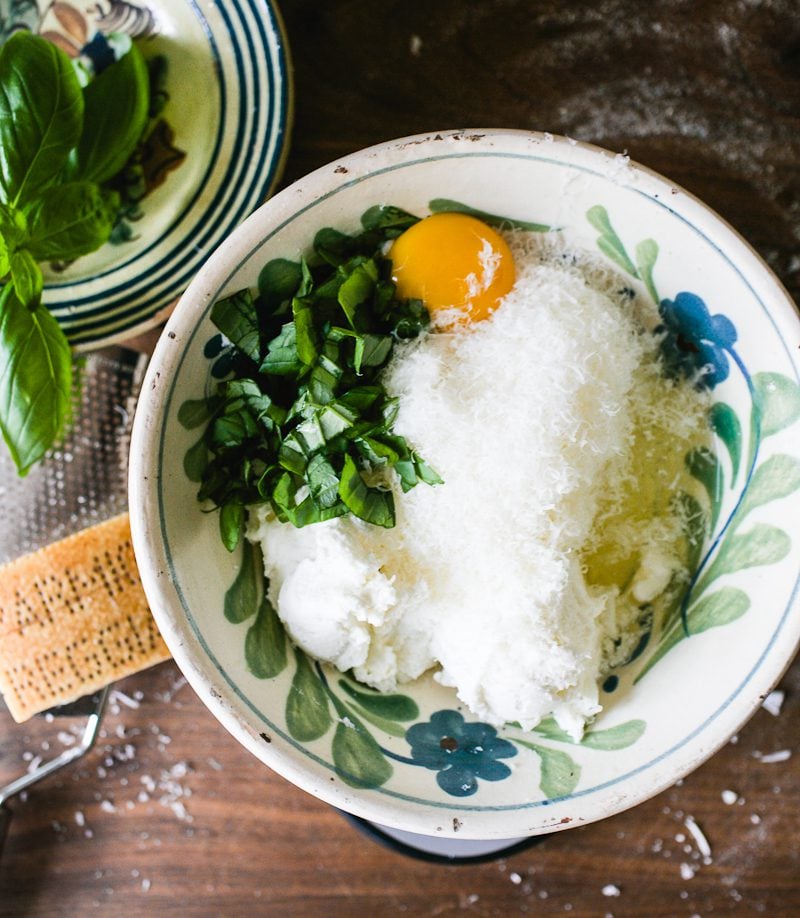
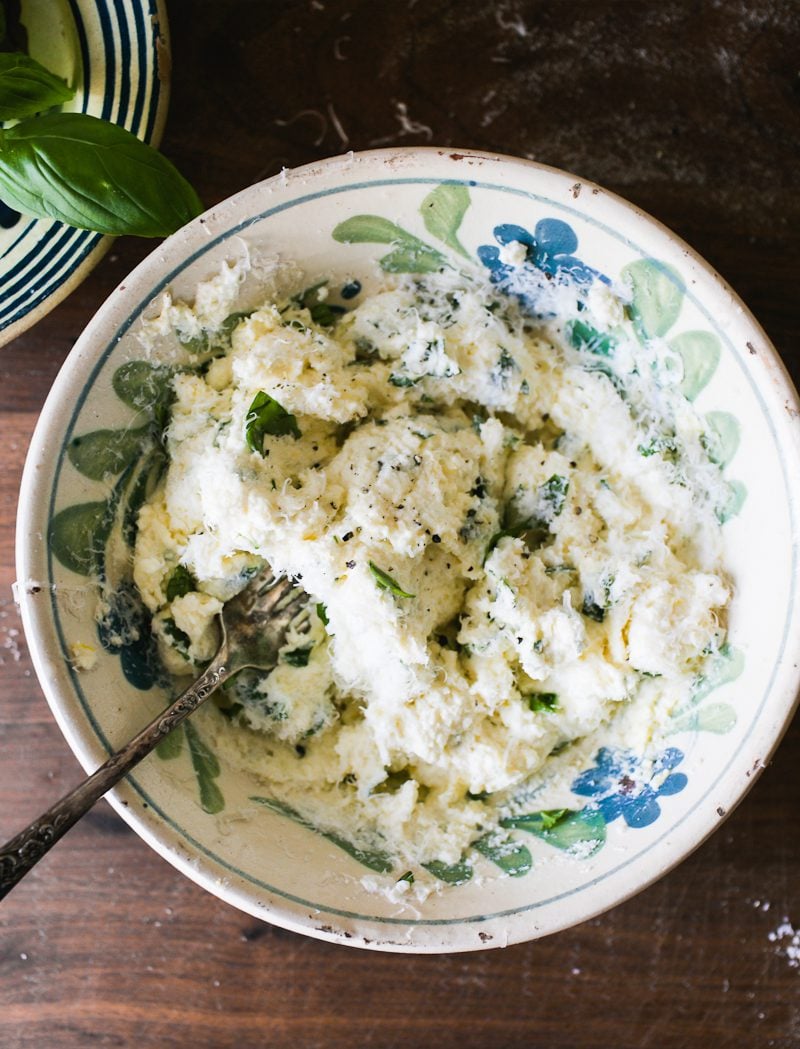
Step #2: Make Ravioli Filling
- While the pasta dough is resting: combine the drained ricotta, mascarpone, chopped basil leaves, Parmesan cheese and egg. Season with salt and pepper; mix well. Give it a taste (it should be highly seasoned). Cover and chill until ready to use. This step can be done 1-2 days in advance.
What is Mascarpone cheese? It’s a soft, Italian-style “cream cheese” that’s mildly sweet, not so much tangy. It adds creaminess and structure to the fluffy ricotta cheese filling- don’t leave it out! I do a 50/50 blend of ricotta and mascarpone, which is a great tip I picked up from our restaurant Sfoglia.
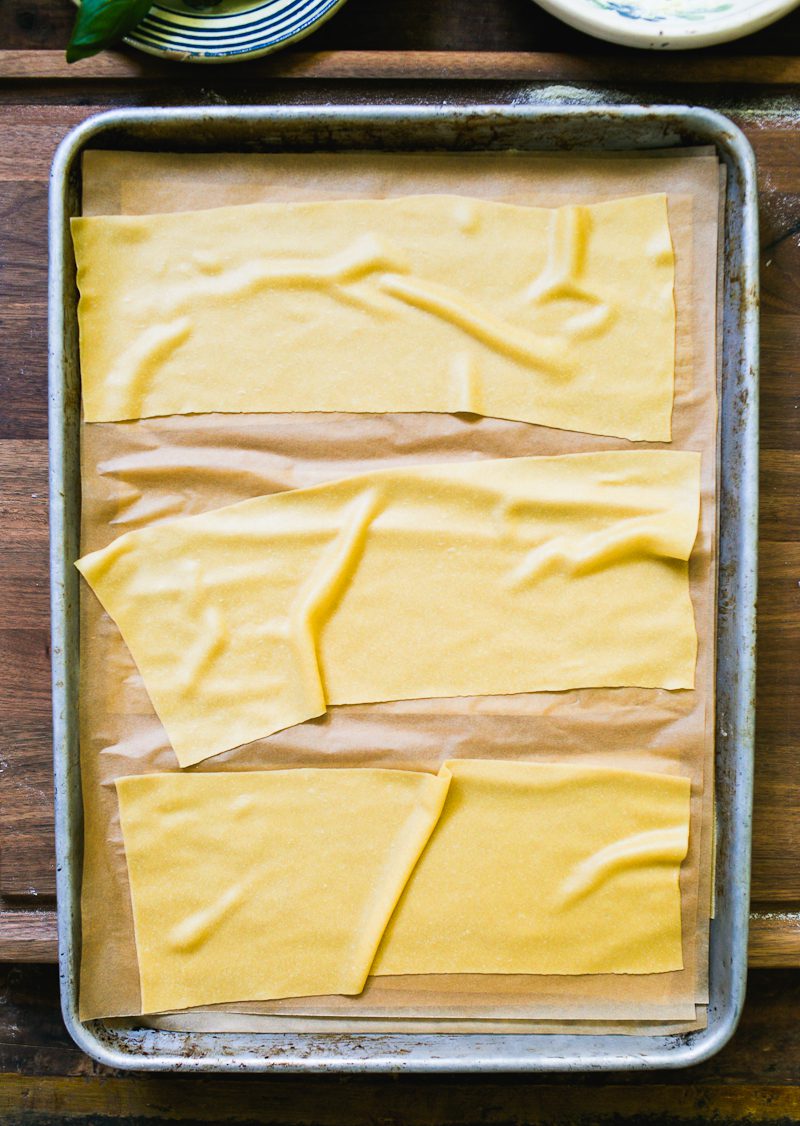
Step #3: Roll Pasta Dough Into Sheets
Before you begin, set up your work station. Find a large, clutter-free space to spread out (I use the kitchen table). Your pasta sheets are going to be long! Dust your work surface and pasta machine with semolina flour to prevent sticking. Line a (2x) sheet pans with parchment paper to fit the inside dimensions, no clunky overhang. Cut 4 additional pieces or parchment to layer in between the pasta sheets as you roll them out; set aside.
- Cut the pasta dough into 4 equal pieces. Flatten one piece into an 8×5-inch disc (re-wrap or cover the remaining pieces so they don’t dry out).
- Send the disc through the roller on the widest/lowest setting. This is #1 on the Kitchen Aid attachment. Send it through a second time. (Note: if using a hand crank pasta machine instead, refer to their specific instructions for rolling the dough for ravioli. The settings are reversed, but the process is the same).
- Continue to roll the dough through settings #2-5 (2x on each setting) until the pasta sheet is slightly translucent and you can see your hand underneath, about 1 mm thick.
- When finished, lightly trim the rounded edges. Cut into 10-12-inch long sheets. Your sheets do not have to look perfect- you’ll trim more later on. Place onto your sheet pan and cover with parchment paper. Repeat to roll the remaining 3 pieces of dough.
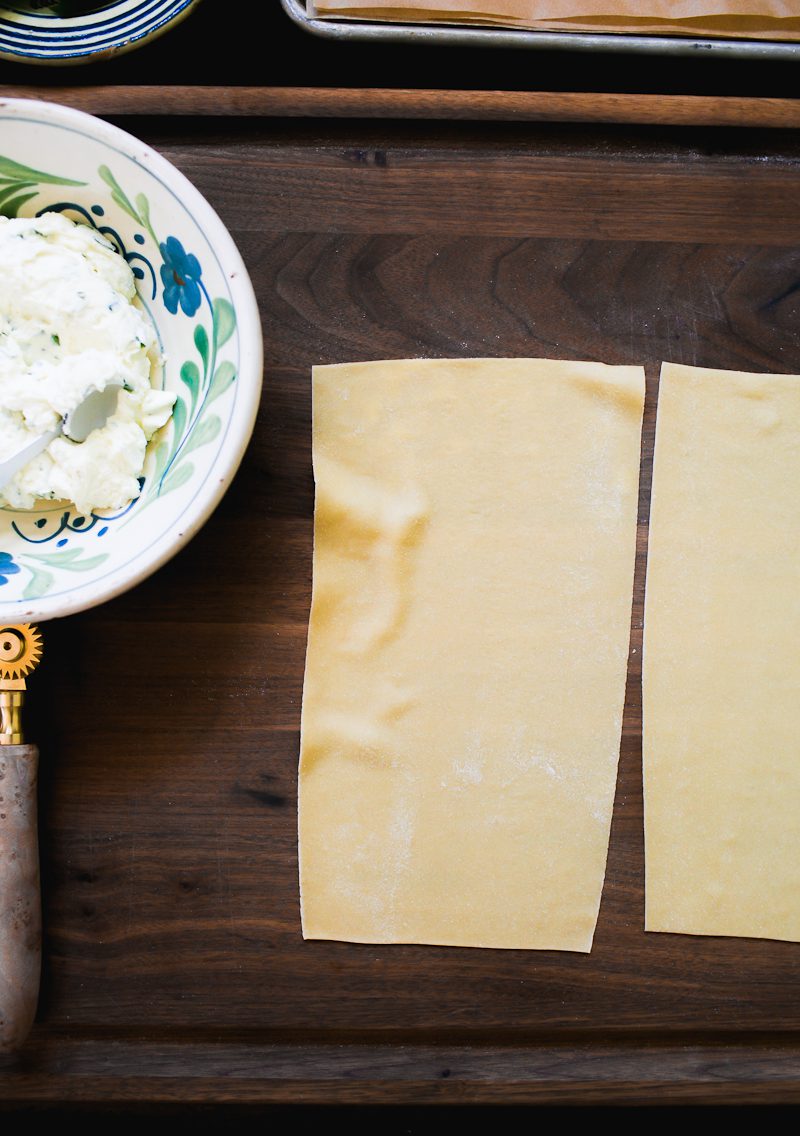
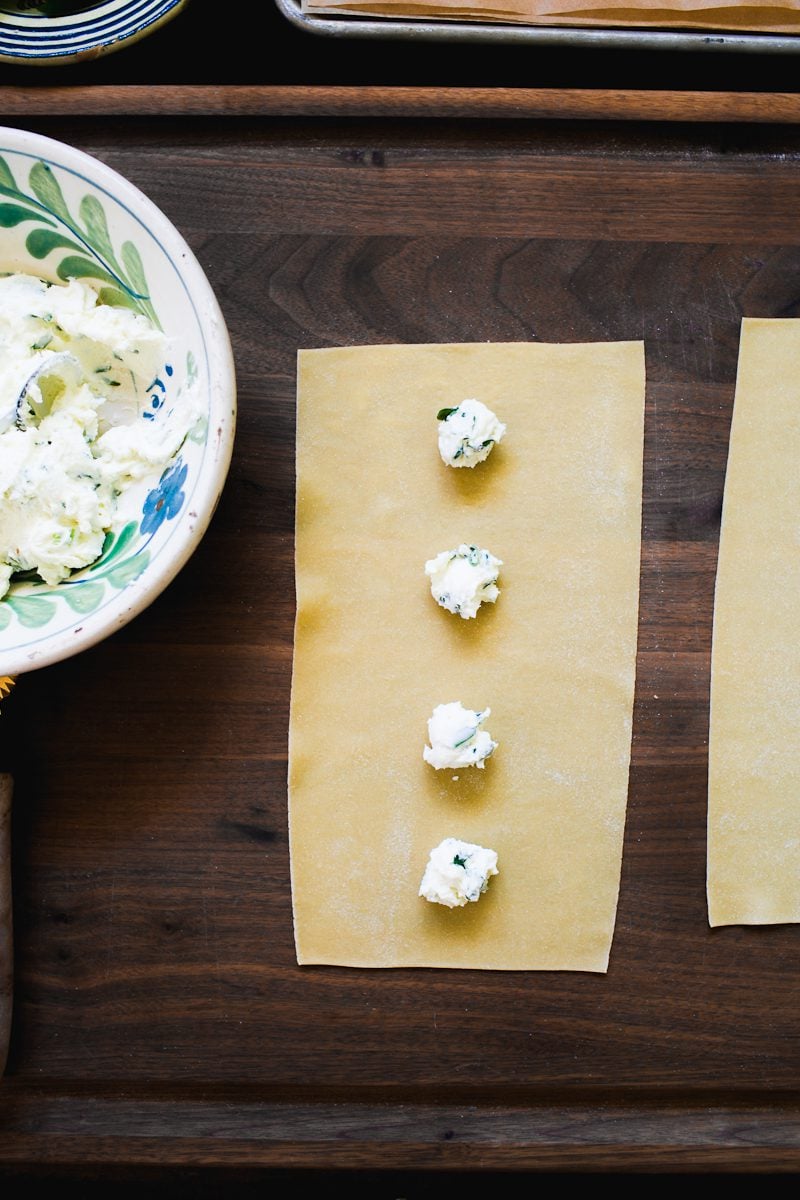
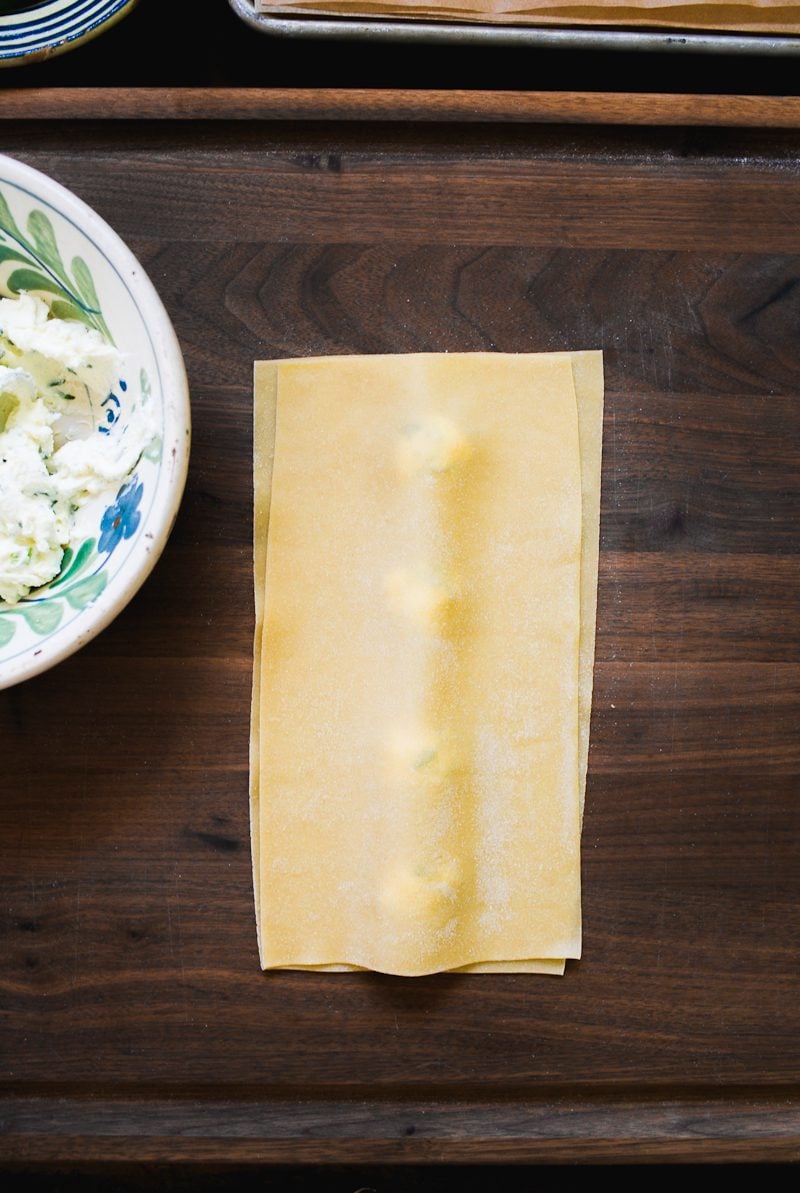
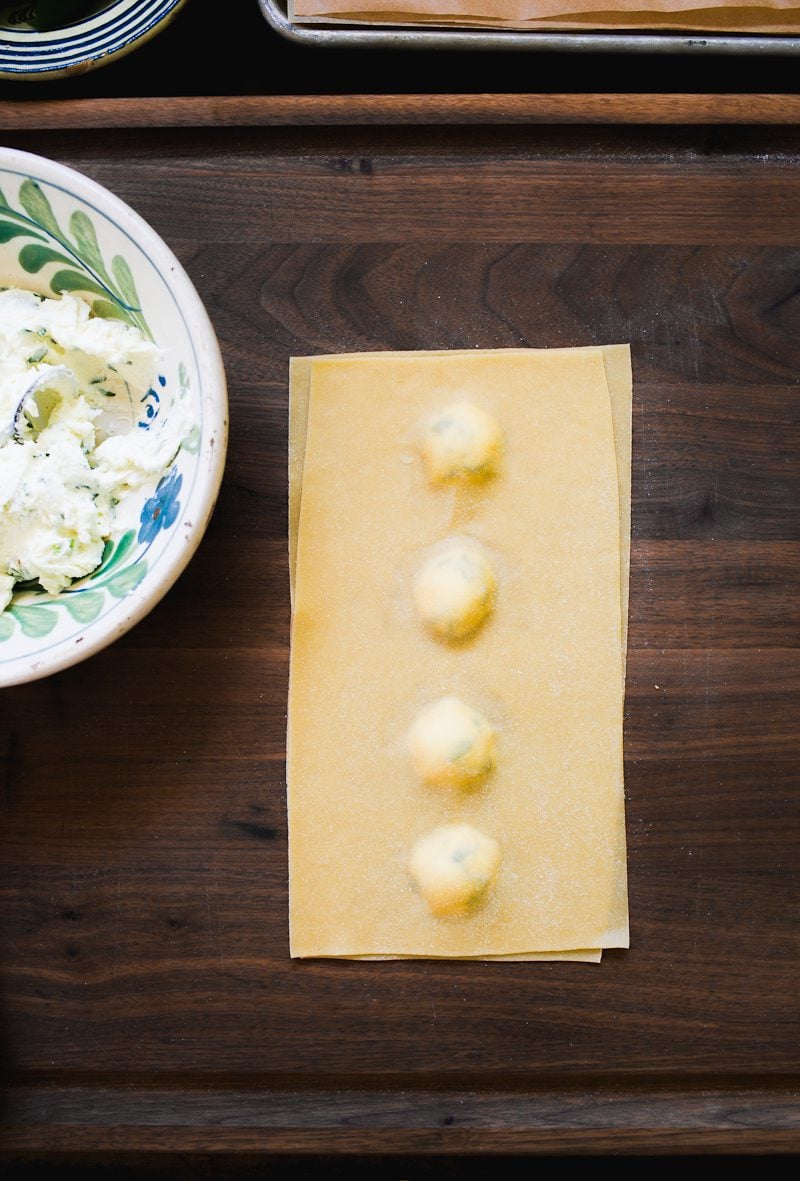
Step #4: Assemble & Cut Ravioli
- Grab a pasta sheet. Dollop the cheese filling (in rounded teaspoons), down the center of the sheet, spaced 2 finger-widths apart.
- Place a second sheet on top, like making a sandwich.
- Smooth the pasta sheet with your fingertips, working around the filling to get the air bubbles out. I use my pinkies. Press to seal the edges and sides. Refer to my video for guidance.
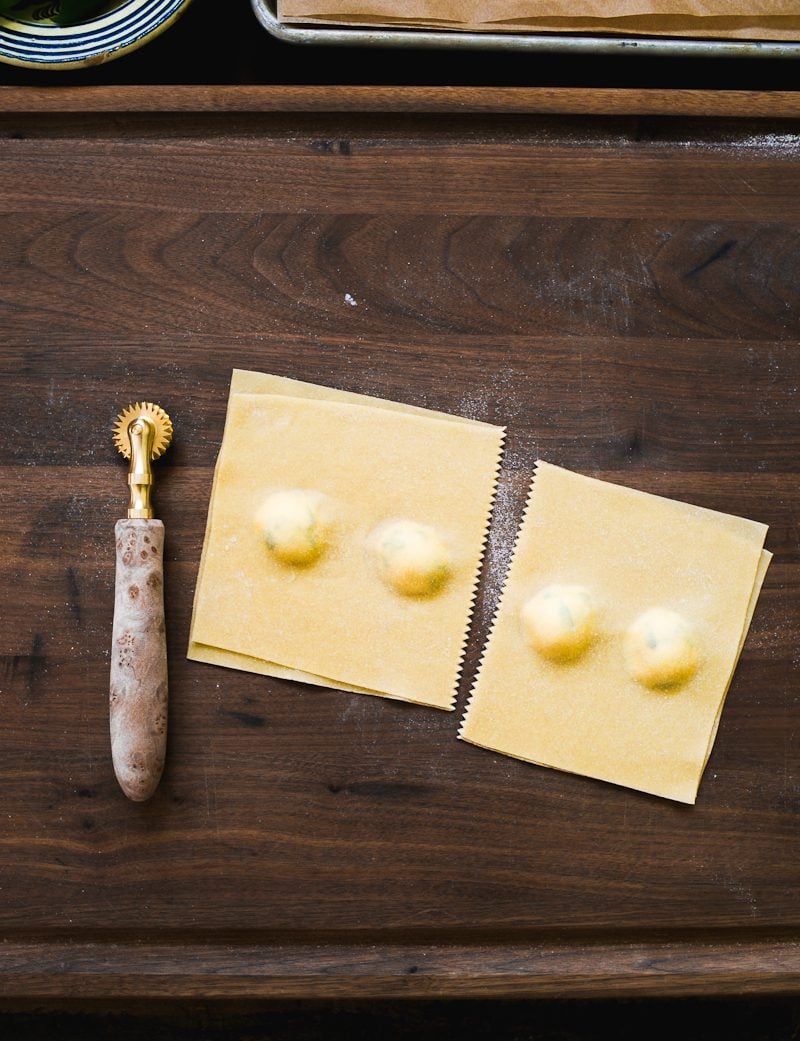
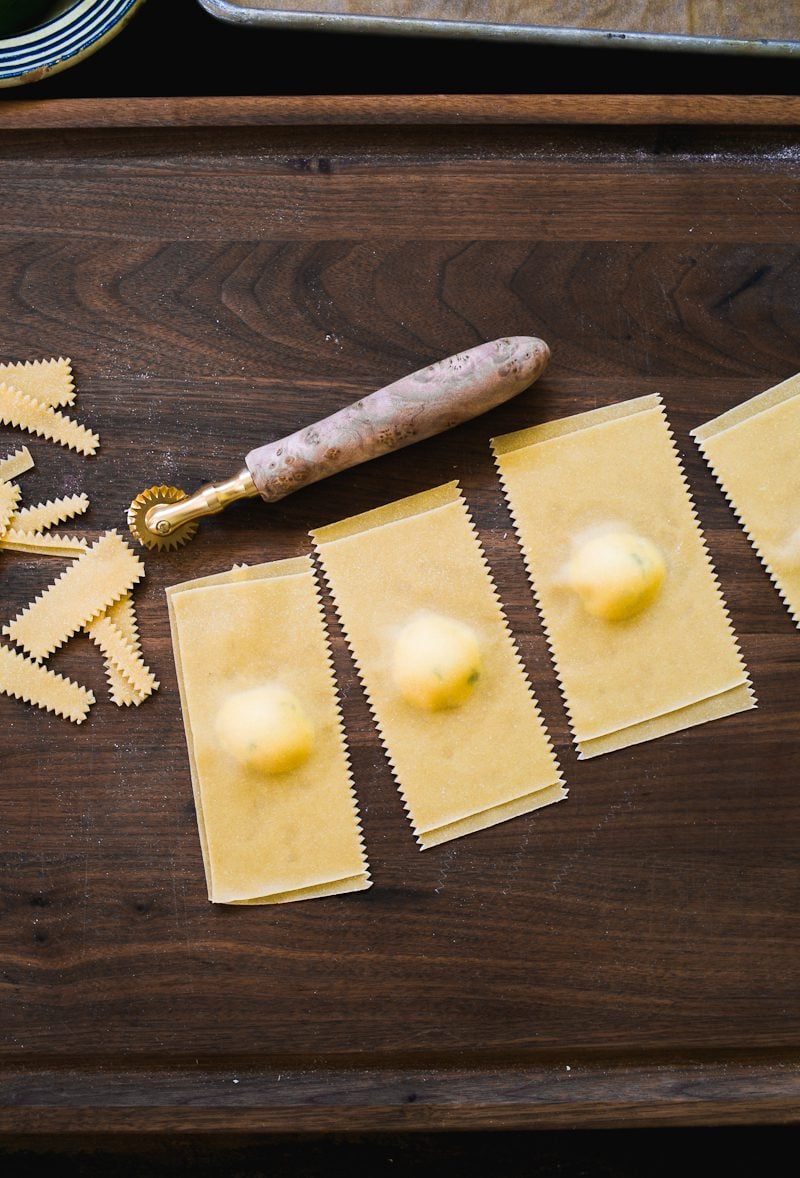
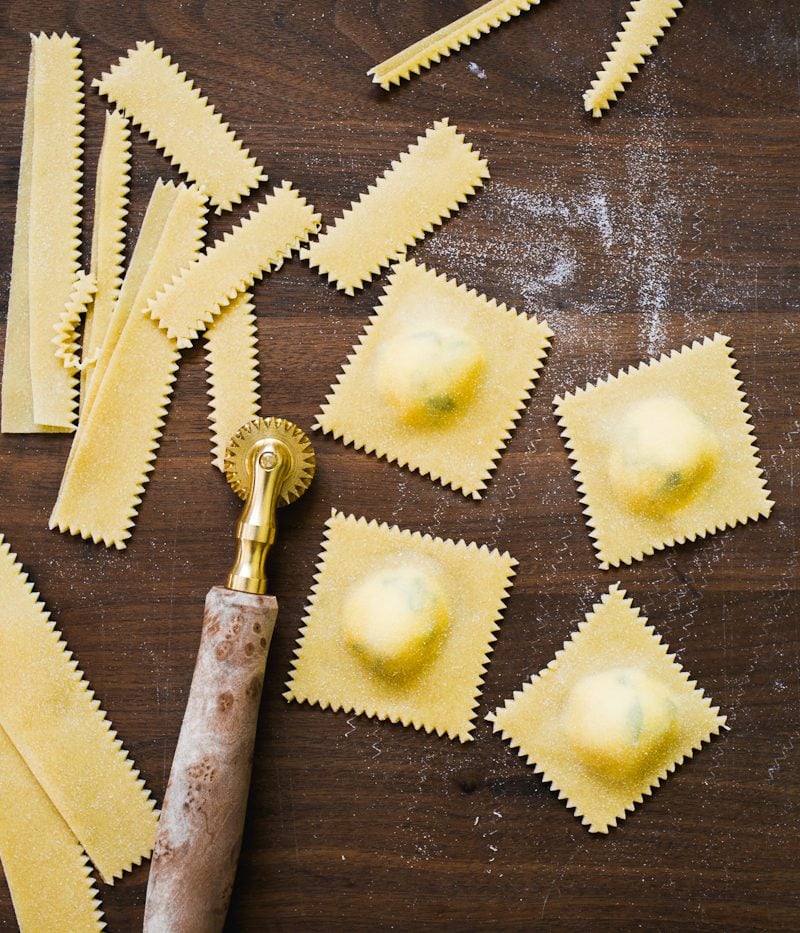
(Assembling Con’t.)
- Cut the ravioli in half and then into strips. Trim into 2 1/2- 3-inch ravioli squares. You’ll end up with lots of pasta scraps. Jump here for ways to utilize them.
- Last step: Transfer the ravioli to the remaining parchment-lined sheet pan dusted with semolina flour. Cover with towel or an inverted sheet pan. Repeat to assemble and cut the remaining ravioli.
How to Store, Chill & Freeze Homemade Ravioli
Homemade ravioli is best enjoyed on the same day its made. If they sit around for too long, they’ll get too soft and soggy, and the filling will seep out through the dough. You don’t want that. Either cook them right away or choose one of the storage options below.
- At Room Temperature (1 hr): Arrange homemade ravioli on a parchment-lined sheet pan dusted with semolina flour to prevent sticking. Cover tightly with plastic wrap. Store at a moderate room temperature for 1 hour.
- To Refrigerate (4 hours): Arrange the ravioli as indicated above. Chill up to 4 hours. Do not refrigerate overnight. The pasta will oxidize and discolor, and the filling will create soggy ravioli.
- To Freeze (1 month): Arrange the ravioli as indicated above, minus the plastic wrap. Freeze directly on the sheet pan. Once frozen solid, transfer to a parchment-lined air-tight container. Freeze up to 1 month.
How To Cook Homemade Ravioli
When dealing with fresh homemade pasta of any kind, I recommend cooking a test batch first to gauge the correct time. Plunge 1-2 ravioli into a pot of boiling water- make sure it’s generously salted. Cook for 3-6 minutes or more, depending on thickness (the thicker the pasta, the longer the ravioli will take to cook). Taste for doneness. When finished, gently transfer the ravioli to a serving dish with a slotted spoon or fine mesh strainer- be careful, they are delicate! Top with sauce.
To Cook Frozen Ravioli: No need to defrost beforehand; cook directly from frozen. Drop a few ravioli into a pot of boiling salted water. When the water returns to a boil, cook for up to 5 minutes or more until tender.
My Sample Cooking Timeline
- Day 1 (AM): Drain ricotta overnight & make ravioli sauce (see sauce suggestions below). Both can be done 1-2 days in advance. The sauce can be frozen until ready to use.
- Day 2 (AM): Make pasta dough, the cheese filling & assemble the ravioli. When finished, my recommendation is to freeze them immediately if not cooking within the hour. They will hold their shape perfectly.
- Day 2 con’t (PM): Cook Ravioli. Warm up your sauce. Dinner is done in under 30 minutes.
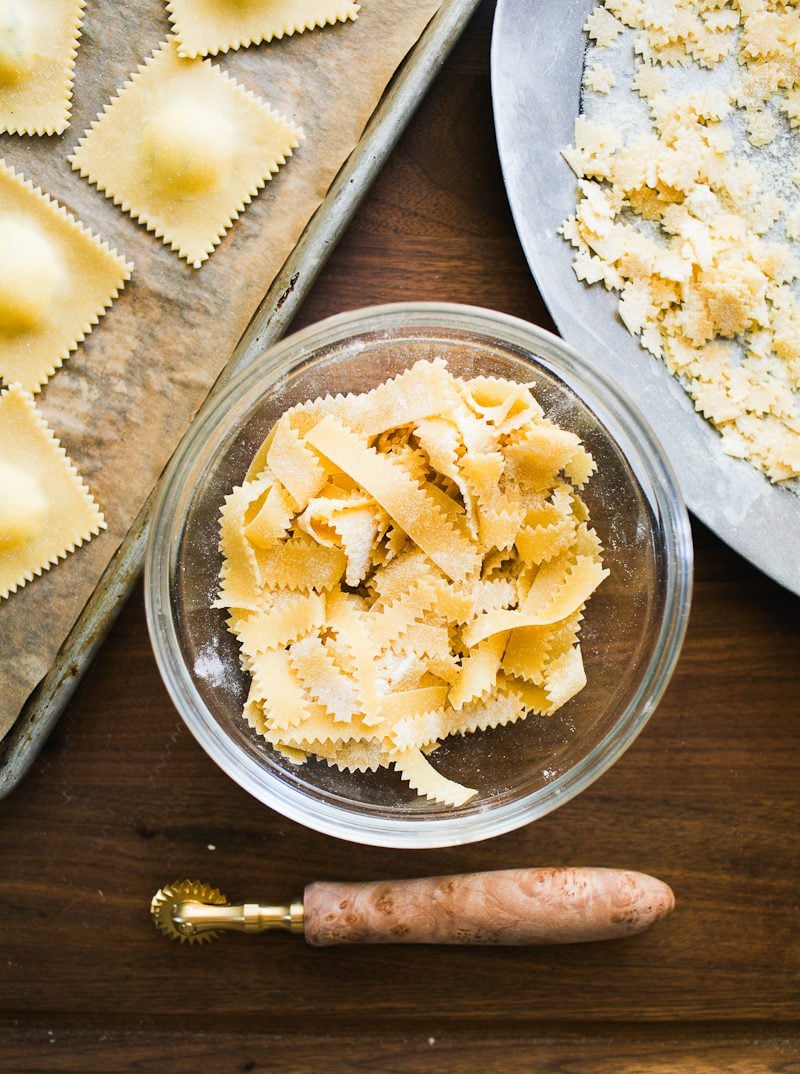
What About the Pasta Scraps?
Oh yes. Scraps. You’ll have lots when making homemade ravioli. So first, let me back up quickly to clarify why.
Ravioli can be made several ways. The easiest “sandwich-style” method outlined here, produces a reasonable amount to assemble by hand without burning out, about 16-32 ravioli depending on if you do 1 or 2 rows of filling per sheet.
The more advanced “fold over” method (outlined in my homemade mushroom ravioli recipe) yields up to 50 ravioli to assemble by hand (!!!) with less scraps to deal with. See where I’m going with this?
So. Pasta scraps. Either discard or collect as you go, keeping them covered and separated to prevent sticking and/or drying out. Then use your fluted ravioli cutter to make decorative strips or little shapes as pictured above.
I dry out my scraps over 2 days and store in an air-tight container. When ready to cook, I toss the dried pasta strips with my Ragù Bolognese with peas and tons of Parmesan cheese. The little shapes go into homemade chicken soup.
Best Sauces For Homemade Ravioli
- Ragù Bolognese Sauce
- Quick Sicilian-Style Tomato Sauce
- Easy Golden Butter & Sage Pasta Sauce
- Quick Homemade Sausage Ragù
- Authentic Pomodoro Sauce (Fresh or Canned)
- Classic Italian Basil Pesto (Pesto alla Genovese)
- Easy Pesto alla Trapanese (Sicilian Pesto)
More Fresh Homemade Pasta & Ravioli Recipes to Try!
- Easy Ground Pork Meat Filling For Ravioli
- Homemade Mushroom Ravioli
- Fresh Homemade Butternut Squash Ravioli w/ Butter & Sage Sauce
- Beginner’s Guide to Fresh Homemade Pasta Dough
- Best Sourdough Pasta (1 Hour or Overnight)
- Beginner’s Guide to Fresh Homemade Lasagna Noodles
- Beginner’s Guide to Fresh Homemade Gnocchi
- How to Make Perfect Pappardelle Pasta
- Fresh Spinach Pasta Dough
Watch The Video:

Beginner’s Guide to Fresh Homemade Ravioli
- Prep Time: 2.5 hours
- Cook Time: 5 minutes
- Total Time: 2 hours 5 minutes
- Yield: 4 people
- Category: Homemade Pasta
- Method: Boil
- Cuisine: Italian
- Diet: Vegetarian
Description
This recipe will teach you how to make fresh homemade ravioli (from scratch!) with step-by-step instructions & video. I’ve also included a creamy, 5-ingredient cheese filling with basil. For timing, my method is broken down into 4 steps: making pasta dough, making the cheese filling, rolling the pasta dough into sheets and finally: assembling the ravioli. See storage options (at the end of the recipe) for chilling and freezing ravioli for future use. Don’t forget to read my notes and tips below!
Notes & Tips:
- Ravioli Yield: You’ll get approximately 16-32 ravioli from this recipe, depending on how large you make them and if you do 1 or 2 rows of filling during the assembly. It’s enough for 4 ppl as a light first course or main meal- you would know this best.
- Think ahead. Before you begin, remember two things: the ricotta must be drained overnight (no exceptions!) AND you’ll need sauce to serve with the ravioli, like a simple pomodoro sauce. I tackle both 1-2 days in advance.
- Drain store-bought ricotta. Skip this step, and you’ll be sorry. The cheese filling will be watery, grainy and seep out all over the place. I measured a whopping 80 g (3 oz) of residual liquid from a 454 g (1 lb) container of drained ricotta! Use any leftover ricotta to make my One-Bowl Italian Ricotta Cake.
- Make space. You’ll need a large, clutter-free work surface to roll out the pasta dough. The kitchen table is ideal. Don’t overlook this tip. Rolled out pasta sheets can measure up to 3ft. long!
- Skip the fancy tools: You do not need ravioli molds or ravioli makers to get started. A simple ravioli cutter (aka: fluted pastry wheel) is sufficient for pretty decorative edges reminiscent of baby shark teeth. Or, use a large knife and upgrade later.
Ingredients
For the Pasta Dough
(1x) Fresh Homemade Pasta Dough (ingredients below) or Sourdough Pasta
- 300 g Tipo 00 Flour*
- 3 large eggs*
- 1 large egg yolk
- Olive oil*
- Semolina flour, for dusting
*Note: For the Tipo 00 flour, I recommend Molino Grassi or Caputo. For the eggs & yolk, the total combined weight (cracked) should be 185 g. Because eggs size vary, make up the difference (if needed) with olive oil. For example, if you end up with a total of 175 g eggs + yolk, you’ll need 10 g olive oil to equal 185 g. Olive oil makes the dough more soft, supple and satisfying to work with.
Ravioli Cheese Filling
- 100g (1/2 cup) drained whole milk ricotta or 100 g homemade ricotta
- 100 g (1/2 cup) mascarpone cheese
- 10 g (1/4 cup) chopped basil leaves
- 30 g (.90 oz) freshly grated Parmesan cheese
- 1 egg
- Salt & Pepper, to taste
Pasta Equipment
- Kitchen Aid Stand Mixer (w/ roller attachment) OR Hand-Crank Pasta Machine to roll the pasta dough into sheets.
- Parchment paper (6 pcs). I like pre-cut sheets for convenience
- Sheet pan
- Digital scale
- Fluted ravioli cutter (or large knife)
Instructions
Before you begin: If using store-bought ricotta, drain it overnight (if using my homemade ricotta recipe, skip this step). Scoop the ricotta into a fine mesh strainer set over a bowl. Cover and chill overnight and/or up to 2 days in advance. Use this time to think about your ravioli sauce too.
- Make Pasta Dough: Add the flour, eggs and olive oil (if using) to a food processor fitted with the metal blade. Process to form dough, about 15-20 seconds. Remove to your work surface and cover with an upturned bowl for 5 minutes- it will be much easier to knead in the next step. Then, knead the dough into a ball, about 1-2 minutes (don’t worry about technique here, the food processor does most of the kneading for you). Cover again, and let rest for 30 minutes to 1 hour to relax the gluten. I prefer a 1 hour rest for long pasta sheets. Tip: Use this resting time to make the ravioli filling.
-
Make the Ravioli Filling: Combine the drained ricotta, mascarpone, chopped basil leaves, Parmesan cheese and egg. Season with salt and pepper; mix well. Give it a taste (it should be highly seasoned). Cover and chill until ready to use. This step can be done 1-2 days in advance.
- Set up your work station: Choose a large, clutter-free work surface to spread out (I like the kitchen table). Dust your work surface and the pasta machine/roller with semolina flour to prevent sticking. Line (2x) sheet pans with parchment paper, no overhang. Cut 4 additional pieces to layer in between the pasta sheets as you roll them out; set aside.
- Roll Pasta Dough Into Sheets: Cut the pasta dough into 4 equal pieces. Flatten one piece into an 5×8-inch long disc (re-wrap or cover the remaining pieces so they don’t dry out). A rolling pin helps with this step.
- Send the disc through the roller on the widest/lowest setting. This is “#1” on the Kitchen Aid attachment. Send it through a second time. Note: if using a hand-crank pasta machine, refer to their specific instructions for rolling pasta sheets for ravioli. The process is the same, but the settings are different.
- Continue to roll the dough through settings #2-5 (2x on each setting), dusting with semolina flour in between if the pasta gets sticky. You can also cut the sheet in half if it gets too long. The pasta sheet is ready when it’s slightly translucent and you can see your hand underneath, about 1 mm thick.
-
When finished, lightly trim the rounded edges. Cut into 10-12-inch long sheets. The sheets do not have to look perfect- you’ll trim more later on. Place onto your sheet pan and cover with parchment paper. Repeat to roll the remaining 3 pieces of dough.
- Assemble & Cut Ravioli: Grab a pasta sheet. Dollop the cheese filling (in rounded teaspoons), down the center of the sheet, spaced 2 finger widths apart. Place a second sheet on top, like making a sandwich. (Tip: If you’re feeling confident, you can do two rows of filling, instead of one. Two rows is not necessarily harder; it requires more practice and patience when smoothing out the pasta sheets. You will have enough cheese filling to do so, and your total number of ravioli will increase. Perhaps start with one row, and then work your way up if you’re in the mood).
- Smooth the pasta sheet with your fingertips, working around the filling to get the air bubbles out. Press to seal the edges and sides. Refer to my video for guidance.
- Cut the ravioli in half and then into strips. Trim into 2 1/2- 3-inch ravioli squares. Transfer the ravioli to the remaining parchment-lined sheet pan dusted with semolina flour. Cover with towel or an inverted sheet pan. Repeat to assemble and cut the remaining ravioli.
Storage Options:
Homemade ravioli is best enjoyed on the same day its made. If they sit around for too long, they’ll get too soft and soggy, and the filling will seep out through the dough. Cook right away, or choose one of the storage options below.
- At Room Temperature (1 hr): Arrange homemade ravioli on a parchment-lined sheet pan dusted with semolina flour to prevent sticking. Cover tightly with plastic wrap. Store at a moderate room temperature for 1 hour.
- To Refrigerate (4 hours): Arrange the ravioli as indicated above. Chill up to 4 hours. Do not refrigerate overnight. The pasta will oxidize and discolor, and the filling will create soggy ravioli.
- To Freeze (1 month): Arrange the ravioli as indicated above, minus the plastic wrap. Freeze directly on the sheet pan. Once frozen solid, transfer to a parchment-lined air-tight container. Freeze up to 1 month.
How to Cook Homemade Ravioli:
When dealing with fresh homemade pasta of any kind, I recommend cooking a test batch first to gauge the correct time. Plunge 1-2 ravioli into a pot of boiling water- make sure it’s generously salted. Cook for 3-6 minutes or more, depending on thickness (the thicker the pasta, the longer the ravioli will take to cook). Taste for doneness. When finished, gently transfer the ravioli to a serving dish with a slotted spoon or fine mesh strainer- be careful, they are delicate! Top with sauce.
To Cook Frozen Ravioli: No need to defrost beforehand; cook directly from frozen. Drop a few ravioli into a pot of boiling salted water. When the water returns to a boil, cook for up to 5 minutes or more.
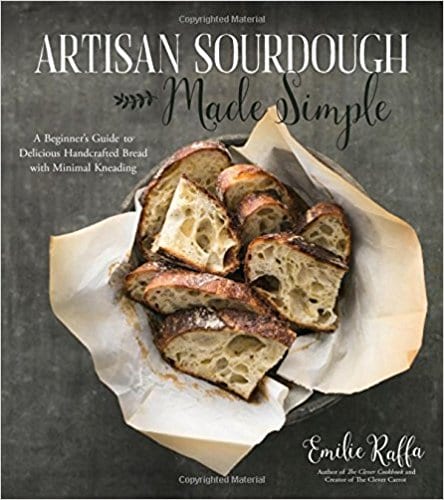

Comments
Charisse says
Curious why you can’t collect the scraps and roll them into a new sheet?
Emilie Raffa says
Great question. The texture is not as soft like cookie or pastry dough; fresh pasta dough is a lot drier so it won’t stick together as easily. You could certainly give it a try though!
Melody says
Can I make the dough in my kitchen aid mixer instead of a food processor?
Emilie Raffa says
Sure can. Use the dough hook to mix the ingredients. Once combined knead on speed #1 or #2 for about 4 minutes or longer.
Melody says
Great, thanks. I am giving it a go tomorrow, my first attempt – wish me well :-)
Mike says
1) Delicious. I have been making my own pasta for a while, but I came here for some guidance on ravioli in particular.
2) If you missed the part where you need to drain the ricotta, do not fear. Take some paper towels and a firm cutting board and you can press the liquid out of your ricotta. I pressed 30g of liquid out of the initial 100g of ricotta that I threw on the scale.
Thank you!
Joe Zeff says
For those of you who don’t know, 00 flour is just Italian for pastry flour. In an emergency you can use equal amounts of AP and cake flour BY WEIGHT, not volume.
Emilie Raffa says
Joe, this is an excellent tip. Thanks for sharing.
Guylene Weister says
I don’t know how much flour and olive oil to use if I’m measuring in cup increments
Jim says
So simple recipe and great instructional video, love all your work
Joe Catoir says
Okay I saw eggs and olive oil then if the eggs didn’t weigh enough add oil I’ve oil to bring it to the correct amount. I didn’t think that was the only olive oil you put. That’s what I did and it came out fine.
Joe Catoir says
How much olive oil do you add to the dough
Emilie Raffa says
Hi Joe! It depends on the total (cracked) weight of your eggs. 185 g is the number you want. So for example, let’s say you crack and weigh 3 large whole eggs + 1 large egg yolk per the recipe, and the total weight is only 175 g. You’ll need 10 g of olive oil to make up the difference to equal 185 g.
Mary Ann says
We had a Christmas craving for homemade ravioli. Your method and recipe helped us have a wonderful dinner. The instructions and photographs helped so much. We made a mushroom filling with a pesto and browned butter sauce. So good for a first time adventure!
Thank you and happy holidays! 12-25-2022
Emilie Raffa says
Mary Ann, thanks so much for your kind feedback. This was a thrill to read on Christmas. And your mushroom pesto filling sound absolutely delicious! I’m going to make a note of the combination. Happy New Year!
Robin Wiegand says
What steps for rolling out the dough would you take for those who don’t have a pasta attachment on a kitchen aid?
Sarah says
After getting the pasta attachment for my kitchen aid I couldn’t wait to learn how to make pasta. It makes sense to use those sheets to make ravioli. Can’t wait to try this method. Your instructions are super clear and thorough as always. Love the video too!!
Emilie Raffa says
You’re very welcome, Sarah :) Yes! You can use the pasta sheets to make ravioli per the instructions here, or lasagna noodles and even decorative pasta if you have a fluted pastry wheel.